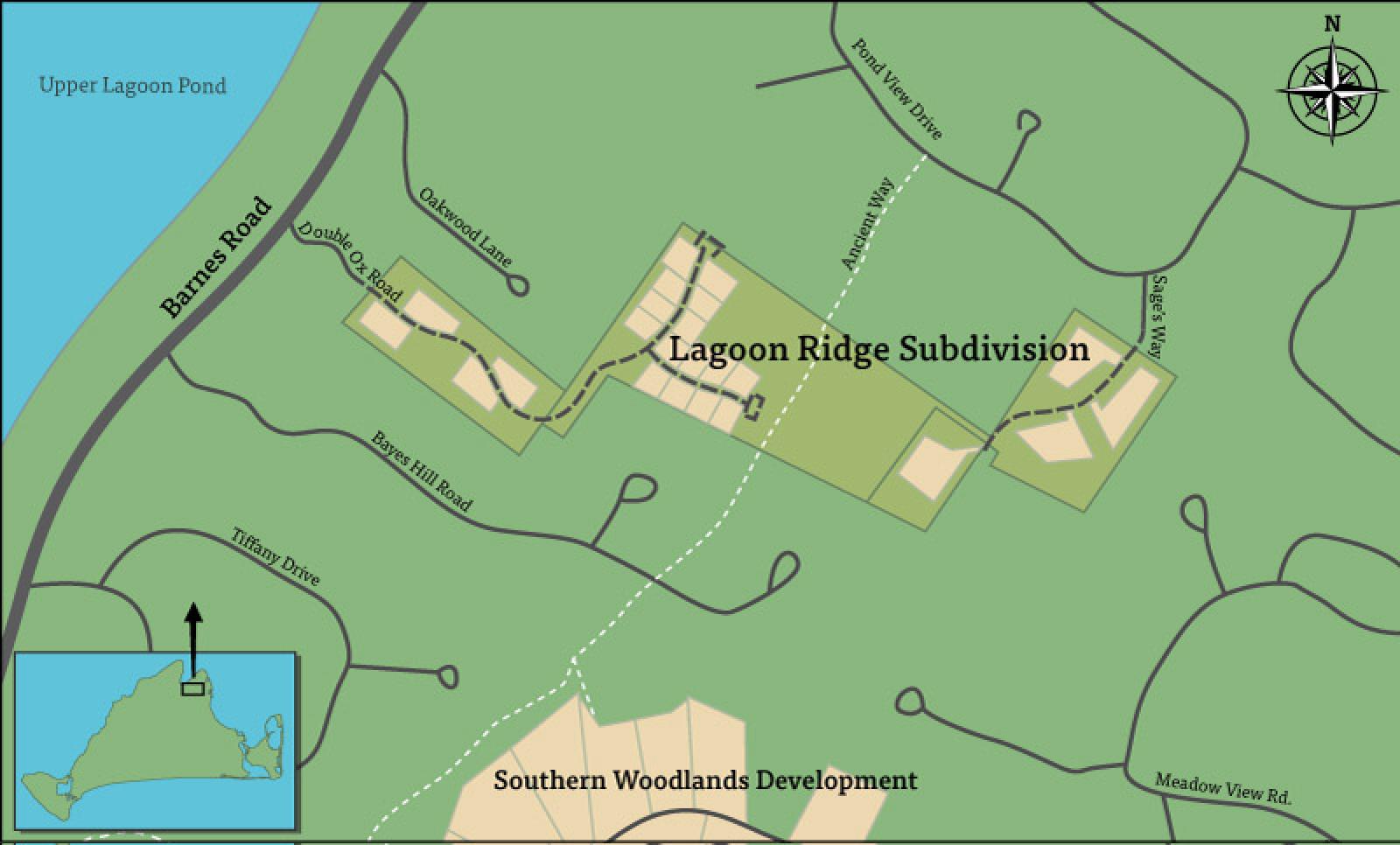A long-planned subdivision off Barnes Road in Oak Bluffs returned last week to the Martha’s Vineyard Commission, which is reviewing the project as a development of regional impact (DRI).
If it is approved it would be the first project to make use of a bylaw in Oak Bluffs that promotes open space and affordable housing in a cluster design.
But the process has highlighted the challenges of parallel town and MVC review.
The commission approved a preliminary plan nearly two years ago with a long list of conditions that the developer has incorporated into the definitive plan now before the commission.
A public hearing last week dwelled mostly on plans to reduce nitrogen impacts from the development on Lagoon Pond to the north, and procedural hangups related to the Oak Bluffs flexible development bylaw, which the town adopted in 2003.
To benefit from the bylaw, six of the lots would be limited to residents over 55, and 60 per cent of the 32.5-acre property would be preserved as open space. In return, the project could have an additional four dwellings.
The subdivision itself has changed little since 2014. It includes 23 lots on three connected areas. Road access would be via Double Ox Road and Hope’s Way to the west, and Sage’s Way to the east. A large central area would have a cluster of 15 small lots, with larger lots to the east and west. Trails running through the property would be preserved where possible, and plans call for the creation of a new fire trail, along with a 20-foot easement for a bike path along part of Barnes Road.
Davio Danielson of Haydenville, who owns the property, has offered two of the lots to Habitat for Humanity for the purpose of building three affordable units and satisfying town and MVC affordable housing requirements. But the offer was declined.
Eric Peters, an Island attorney and chairman of the Vineyard Open Land Foundation, is representing Mr. Daniels in the review process. He noted that the flexible development bylaw mentions units in some cases and lots in other cases, leading to confusion. “We are creating lots, so the proposal is to provide these two lots,” he said, referring to the affordable housing component of the plan.
As is standard practice, the planning board will not rule on the proposal until after the MVC makes its decision, which Mr. Peters called a catch-22, since the commission has required that the project abide by the flexible development bylaw.
Mr. Danielson said he was eager to separate the MVC and planning board requirements to simplify the process. “Within [section] 7.3, it specifically designates the Oak Bluffs planning board as the place where they will determine the meaning of 7.3,” he said of the bylaw, noting that another public hearing will be needed at the town level. “What I’m eager to do is separate out meeting the MVC requirements from meeting the sometimes confusing direction I’ve been getting from the planning board.”
But conversation on Thursday quickly turned to the nitrogen issue, as commissioners sought to better understand how the project will deal with wastewater. The western tip of the property touches a district of critical planning concern (DCPC) around Lagoon Pond, which is among the most impaired estuaries on the Island. Four possible houses within the DCPC would have their own denitrifying septic systems and be limited to one bedroom per 15,000 square feet. The others would connect to an onsite wastewater treatment facility.
Raul Lizardi, an engineer for Holmes and McGrath of Falmouth, described a motorized process where sewage is fed into underground tanks and aerated and denitrified before discharging into a leach field. Solids would be collected and shipped off-Island. He said the process would meet the MVC’s nitrogen threshold for the property, although the technology is relatively new. “The first year will be trial and error,” Mr. Lizardi said.
Mr. Danielson cited examples on the Cape where the technology has worked effectively with little required maintenance. “The pumps are extremely reliable,” he said.
But Island realtor Doug Reece, who is also president of the Lagoon Pond Association, questioned the idea of having the systems maintained by the future homeowners.
“I’ve been involved in a couple of different homeowners associations over the years, and it’s safe to say most of them don’t work very well,” he said at the hearing. “If there’s not enough funds there to help run the system . . . what’s plan B?” He suggested looking into new urine-separating toilets that use electrolysis to neutralize the nitrogen before it enters the ground.
Debbie Bettencourt thought the wastewater efforts were innovative, but wondered how they would affect the lower-income homeowners. “That just seems like the part that doesn’t fit for me,” she said.
In addition to Mr. Lizardi’s review of the wastewater treatment system, the Oak Bluffs board of health has sought its own third-party review, which Mr. Danielson said was a surprise. He added that the board was “well behind” in the process. Paul Foley, the commission’s DRI coordinator, said the town expected a report this week.
Looking ahead, Mr. Danielson has drafted regulations related to the proposed elder-housing units, and has asked the Oak Bluffs planning board for further guidance.
The commission hearing was continued to May 19.




Comments
Comment policy »